The Start of It All
The very first sound recording was made in France by an inventor called ‘Scott’ in 1856…… So those stories about the Edison Phonograph may have sounded good and plausible, but they are actually wrong when it comes to real history. But it is true that the first sound recording medium was the wax and foil cylinder.
It’s strange isn’t it how once something has been achieved or invented, how obvious it seems, particularly with the best inventions.
The first cylinders were rotated directly by hand while the person recording the message shouted down a ‘trumpet’ so that a cutting stylus vibrated, making a groove in the wax. The ‘modulation’ was the depth of the groove, so there was not a lot of dynamic range! Of course, the earliest recordings were almost completely erased by attempts to play them back!
The cylinder as a shape for a recording medium was obviously not too good; it was bulky and difficult to store and it was also quite delicate.
It was a small but important step to go from recording on a cylinder, to recording on a disk. The cylinder had the one advantage that the speed of the groove past the stylus remained constant all the time (once the rotation of the cylinder became motorised), but on a disk, the speed of the groove slows down towards the centre of the record. However, the disk won the day because of its advantages of ease and cost of manufacture, and ease of storage.
Some early disks were recorded the other way around; with the start of the record being in the centre, and the end at the edge… in fact this is how CDs are recorded today.
In 1896 – Eldridge Johnson improved the gramophone with a motor, for a simple and inexpensive machine that became the most popular disc phonograph by 1900; he then merged his Consolidated Talking Machine Co. with another existing company run by Emile Berliner, to create the

Magnetic Recording
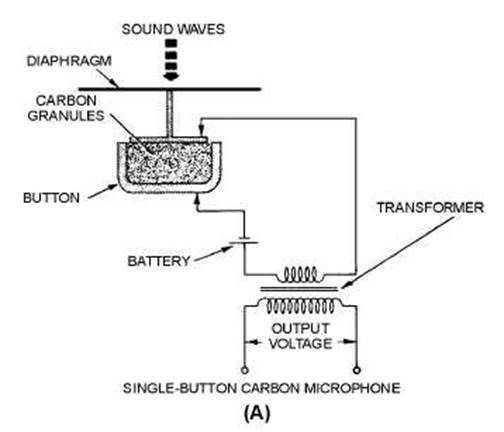 The very first magnetic recorder was developed in 1898 in Denmark by an engineer called Poulsen. He made that intellectual leap from storing sound as waves on a wax cylinder, to storing the information magnetically.
The very first magnetic recorder was developed in 1898 in Denmark by an engineer called Poulsen. He made that intellectual leap from storing sound as waves on a wax cylinder, to storing the information magnetically.
How he did this was to run a current through a carbon microphone*** (divert to explain carbon microphone principle)
Then he had an iron cored magnetising coil in the circuit, and he passed an iron wire through the magnetising field. Speech would modulate the magnetic field, and so magnetise the wire. Some of this magnetism would remain in the wire (remanence), and the sound could be recovered by using a telephone earpiece attached to a sensing coil as the wire was pulled past it.
The first machines had the wire wound on drums, and the movement was done by turning a handle, much the same as on the early cylinder recorders!
In 1900 Poulsen allowed the principle to be taken up by a newly formed American company who worked on developing the machine as a telephone answering device, and by 1917 had a practical working model which was launched as the ‘Telegraphone’.
American Telegraphone Model c.1915
In the end, this really was an idea ahead of its time, and it was not a great success!
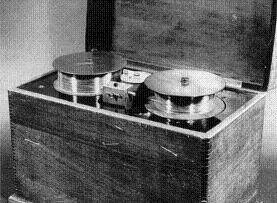
American Telegraphone Model c.1915
The breakthrough came in the 1920s when the German Telefunken company started experimenting with steel tape… yes, flat steel tape like thin ribbon. This was wound onto great drums about a metre across. The first practical machine was made by Kurt Stille in Germany.
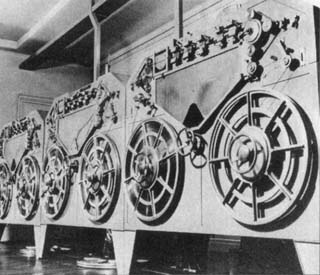
Marconi/Stille Blattnerphone Machines 1939
In the USA, a Dutch engineer called Ludwig Blattner experimented with steel tape as well, bought the use of the rights from Kurt Stille and by 1928 he had an operating ‘tape recorder’. It was a huge device with converted washing machine motors (really!) to drive the ‘tape’ which ran past the electromagnetic record and playback heads at a speed of 5 feet per second.
Now note that speed… it was arrived at arbitrarily by Blattner as being the lowest speed at which the sound quality was acceptable, that is a speed of 60 inches per second. Years later, engineers improved tape, heads, amplifiers and transports to such an extent that they were able to keep on halving the tape speed past the heads. Old professional tape recorders used to run at 30 inches per second, the came 15 IPS, then 7 1/2, then 3 ¾, and finally the speed of the Philips compact cassette which is 1 7/8 inches per second; a multiple of Blattner’s original guess!
But back to Blattner; he actually called his machine , the Blattnerphone, and there were only about 6 ever manufactured. The Marconi company continued with development of the Blattnerphone and an improved version meant that they sold about 25 machines to the BBC for radio rebroadcasting across the British Empire, but they were very troublesome and not a great success, although because there was nothing better, they were in regular use until 1939. The main problems with fine steel tape were the danger aspects…. One was constantly in danger of being cut to ribbons by fast moving razor-blade-thick steel, and the constant problems of tape breakage…. The only way to repair the tape was to weld it together, and all the machines had elaborate electro-welding splicing blocks! In the 1930s and 40s a great deal of research was done reviving the idea of recording on wire; a very much less expensive medium than steel tape!
A very successful commercial recorder was introduced in the USA, called the Webcor 288.
The Webcor 288 1953
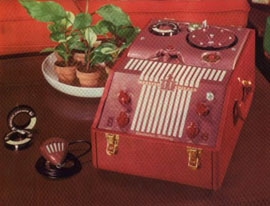 Of all the mediums of magnetic recording, wire still remains at the top of the list in popularity and the Webcor 288 wire recorder is the reason for it. The 288 is the only wire recorder with “Console Response”. Console Response is the result of a new technique used in the construction and design of the sound chamber and provides lifelike, faithful sound reproduction. It is this fidelity of sound that has enabled Webster Chicago to sell more magnetic recorders than all other manufacturers combined. Beginning with the picking up of sound by the sensitive high impedance crystal microphone and ending with the playback of any sound through the powerful amplifier and speaker, the Webcor wire recorder provides the utmost quality every step of the way. From the businessman to the hobbyist, there are thousands of uses for the Webcor 288 ranging from the recording of business conferences to the recording of animal noises. Simple enough for a child to operate, one master control sets the 288 in motion for recording and playback. Features like the elapsed time indicator, neon volume indicator and automatic stops in both directions make the Webcor 288 the best wire recorder investment.
Of all the mediums of magnetic recording, wire still remains at the top of the list in popularity and the Webcor 288 wire recorder is the reason for it. The 288 is the only wire recorder with “Console Response”. Console Response is the result of a new technique used in the construction and design of the sound chamber and provides lifelike, faithful sound reproduction. It is this fidelity of sound that has enabled Webster Chicago to sell more magnetic recorders than all other manufacturers combined. Beginning with the picking up of sound by the sensitive high impedance crystal microphone and ending with the playback of any sound through the powerful amplifier and speaker, the Webcor wire recorder provides the utmost quality every step of the way. From the businessman to the hobbyist, there are thousands of uses for the Webcor 288 ranging from the recording of business conferences to the recording of animal noises. Simple enough for a child to operate, one master control sets the 288 in motion for recording and playback. Features like the elapsed time indicator, neon volume indicator and automatic stops in both directions make the Webcor 288 the best wire recorder investment.
WEBCOR by Webster-Chicago $167 Prices slightly higher west of the Rockies. Copyright 1953
About 100,000 of these machines were sold in the USA; they sold for $167 and were as popular as popular as cassette machines were in the 1980s.
Movie Sound
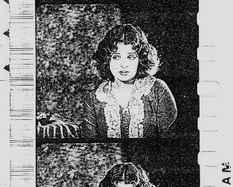
Variable Density Recorded Soundtrack
All through those early days the movie makers in California were searching for ways of synchronising sound to their films.
The earliest attempts used gramophone records with all sorts of contraptions to try to maintain some sort of synchronisation, they achieved it for the first time with dialogue, with the film ‘the Jazz Singer’ in 1927.
But the equipment for both recording and playing back these soundtracks was horribly unreliable, and there had to be a better way of marrying up the sound with the picture all on one medium… and this was of course, the optical soundtrack.
Some early forms of soundtrack were actually mechanically recorded!
The vision part of the film was edited, and a black unexposed strip was left down one side of the film.
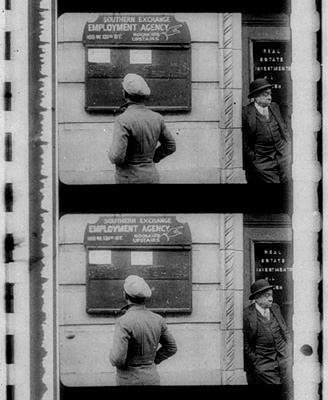
Variable Area System By RKO 1935
The film was then run through a special projector with an angled cutting stylus on the side, and sound and dialogue was fed to a coil around the stylus, which moved much like a loudspeaker. This removed areas of ‘black’ from the film so that when it was run through a projector with a steady light source, and a photo-cell, the mechanically cut ‘sound track’ interrupted the light. The interruptions went to an amplifier which played back the ‘recording’!
Before very long this system was discarded in favour of a much more sophisticated ‘galvanometer’ type recorder which shone reflected light via a mirror onto unexposed film. The mirror was attached to a small lightweight coil hanging in a magnetic field. Modulation in the coil caused the mirror to rotate slightly, altering the beam of reflected light. This coil could be accurately modulated and so a ‘picture’ of the sound waveform could be exposed directly onto the film.
There were many variations of the optical track, from the simple single-track arrangements right up to running a separate 35mm soundtrack ‘film synchronised to the picture with up to 6 optical tracks recorded on it. The most famous example of this is of course the Disney film ‘Fantasia’.
The two systems, variable density and variable area both suffered from excessive background noise due to the ‘graininess’ of the film…. The engineers of the time did not realise that actually the ear is more sensitive to a wide range of signals (sound) then the eye is to light. In the RKO system, which proved to be the better of the two, the recorder designers came up with some clever noise suppression, by increasing the ‘black’ area during quiet passages, which shut off the light, which in turn minimised the hiss caused by the film grain.
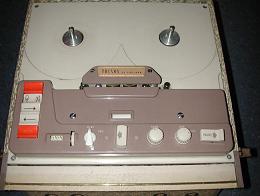
A Slightly Later Version of The Truvox Deck. 1956
Magnetic recording onto tape started to get to a degree of sophistication in the mid 1950s. At that time I was in the 4th form at a Grammar school in Tunbridge Wells. My father, who worked for the Civil Service in aeronautics, was a keen amateur with electronics, and we decided to work on a project to make a magnetic tape recorder. Actually manufacturing the deck itself was a bit beyond us, so we bought a deck made by the ‘Truvox’ company and used that as the basis. The amplifiers were based on circuits published in Amateur Wireless magazine and we built the whole thing into a metal frame about the size of a washing machine!
But we are supposed to be talking about recording media…..The first tape available in 1954 was actually paper based. The iron oxide was made into a sort of paint during the manufacturing process, and it stuck very well to Kraft paper. Practically, it was a good medium, but the biggest advance to getting good quality on playback was the use of AC bias.
AC Bias
When a tiny section of a recording tape is magnetised and then demagnetised, a portion of the magnetisation remains. This is the effect of ‘hysteresis’. Magnetising the tape with audio via the record head, this effect causes severe 3rd harmonic distortion because the waveform that is recorded is constantly being bent out of shape by this ‘magnetic memory’ in the tape. At the beginning of the 1950s, engineers reasoned that if you applied a high frequency signal over the top of the audio, at a higher level than the audio itself, then there was a good chance that this would destroy this memory effect. This was true, and so magnetic recording took a huge leap forward in quality.
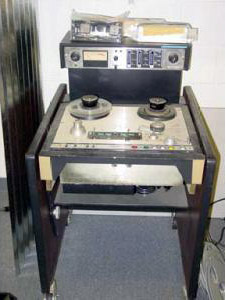
An Early Ampex 350 Professional Recorder
Professional recorders rapidly appeared, with quality far superior to direct cut disks.
In the USA the AMPEX Corporation produced a range of machines which were almost universally used in studios, and they continued developing them with more and more tracks, starting with full track ¼ inch machines, then 2-track, stereo, 3-track [used mainly for the movie industry where the 3 tracks were
- Dialogue
- Music
- Effects
With the use of these machines, and others from Europe like the Studer and Revox recorders, the quality of recordings was rivalling the quality of the microphones, preamplifiers and mixers of the day.
During the 1970s huge advances were made in the all aspects of recording and reproduction, from the introduction of real quality solid-state circuitry, to advances in plastics and emulsions making the tape medium close to perfect.
With the use of these machines, and others from Europe like the Studer and Revox recorders, the quality of recordings was rivalling the quality of the microphones, preamplifiers and mixers of the day.
During the 1970s huge advances were made in the all aspects of recording and reproduction, from the introduction of real quality solid-state circuitry, to advances in plastics and emulsions making the tape medium close to perfect.
More on Disk Recording
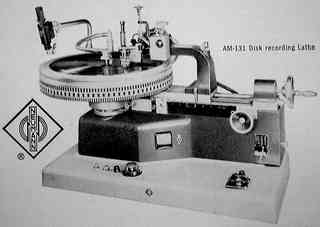
1960s Neumann Cutting Lathe
Cutting disks is exactly the same as a record player in reverse!
The blank disk with no grooves in it is clamped to a powerful turntable.
The cutting stylus is lowered onto the outer edge of the disk, and the modulating signal makes the stylus move side to side, or in the case of stereo records, at 45 degrees for each channel.
The stylus cuts a groove in the disk, helped by a heating coil wound around the stylus. The swarf produced by the cutting action comes off the disk in the form of a single strand, and this is sucked away by a small vacuum pump.
At the end of the recording of the ‘side’, the stylus ‘scrolls’ inwards to a parking groove.
The master disk that is cut is actually an aluminium disk with a coating of acetate on one side, very like thick black paint.
These master disks are, of course, very delicate, and generally cannot be played; or if they are, only by a very lightly loaded magnetic pick-up and then only once!
To produce a commercial record from this master, it is coated with an electro-deposited layer of metal…. This becomes the ‘mother’. For short runs of records, the ‘mother’ can be used direct to produce disks, but more commonly, another impression is taken from the mother, and from that, several ‘sub-mothers’ or ‘stampers’ are made.
Early 78 rpm disks were made of a ‘Bakelite’ type of material. It was hard wearing and easy to produce. Its main disadvantage was that it was very brittle, and so dropping a record was not a good idea.
The introduction of vinyl records running at 45 and 33 1/3 rpm improved quality enormously and also required greater precision on the disk cutting lathe.
Most disks are still cut on ‘Neumann’ lathes similar to the one in the picture, with only detail improvements over the 1960s model.
Coming Up to Date
Digital Media
The start of digital audio recording was a curious inversion of technology; for years the Japanese electronics industry worked on the development of magnetic recording for television, and came up with rival systems called ‘Betamax’ and VHS. In most territories the VHS system won the day commercially, although technically there was not a great deal in it. However, Betamax had a slightly better high frequency resolution and so audio engineers started to experiment with breaking sound down into digital bits and recording it onto a video recorder.
The first commercially successful digital audio recording system was introduced by Sony in 1978 called the PCM-1. This was a coding box that converted audio into a form that could be recorded on a standard ‘Betamax’ video recorder. The quality was equivalent to good professional analogue machines and it had the advantage that it was a reliable system that did not rely on the alignment of a playback machine for its quality.
From that moment on, most audio masters were mixed onto one of the versions of PCM-1.
At about the same time, a further cross pollination of technology happened; the computer business needed faster and more dense methods of storing data, and the floppy disk did not look much like a good long-term solution, so some developments in hard disk technology were moved sideways…. And the CD happened.
- Prototype CD System demonstrated in Europe and Japan.
- Sony agrees to join in collaboration.
- Sony & Philips compromise on the standard sampling rate of a CD — 44.1 kHz (44,100 samples per second)
- Philips accepts Sony’s proposal for 16-bit audio.
- Reed-Solomon code adopted after Sony’s suggestion.
- Maximum playing time decided to be slightly more than 74 minutes.
- Disc diameter changed to 120mm to allow for 74 minutes of 16-bit stereo sound with a sample rate of 44.1 kHz
The choice of the specs for bit density and sample rate were very much dictated by the technology of the time, and a bit of crystal ball gazing by the Philips and Sony engineers. 16 bit was an obvious choice; for high quality reproduction you need a dynamic range sensibly of 80dB. (By dynamic range, I mean the difference in level between background noise and the audio signal clipping.) 16 bit if resolved with modern converters achieves that figure.
For comparison, the dynamic range of optical film is probably 60dB at absolute best, and magnetic striped film is about 10dB better than that.
In normal professional studio practice, the best achievable dynamic range in the recording studio is also about 70dB, but of course, any additional noise after that will reduce the range, so the recording medium needs to be at least 20dB better than the range of the source material to avoid degradation.
That strange figure of 44.1 for a sample rate has a little story attached to it; it was chosen because it was the highest multiple of the practical track length of one helical scan on a ‘Betamax’ recorder! It was choosing to keep the digital processing simple as all mastering in those days was done using the Sony PCM-1 system, and digital rate conversion was extremely difficult.
Hard Drives
And so, to the present day, the 21st century when neither computer speed nor disk space is a problem. CD continues to hold its own as a reasonable quality medium, while for those who think that they can hear the difference there is DVD sound with superior bit numbers and sample rates.
And then there are the variations on hard disk technology in the form of ‘Minidisc’ and MP3 which is really only a name for a bundle of clever mathematical tricks to squeeze realtime sound through the internet with minimum bandwidth.
Solid
And what may be the standard of the future (or almost certainly will be) is the use of solid memory for recording.
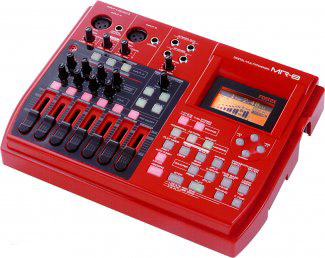 Fostex MR8 8-Track Digital Recorder with Built In FX Fostex has broken the digital recorder price barrier with their new MR8. It’s the world first 8-track that records into solid-state, Compact Flash Card memory — and there’s more! It’s got a USB port for WAV file data transfer to a Windows PC for data editing, CD burning, and backup. And operating the MR8 is more intuitive than many other digital recorders — it’s ideal for users who have no experience in digital multi-track recording.
Fostex MR8 8-Track Digital Recorder with Built In FX Fostex has broken the digital recorder price barrier with their new MR8. It’s the world first 8-track that records into solid-state, Compact Flash Card memory — and there’s more! It’s got a USB port for WAV file data transfer to a Windows PC for data editing, CD burning, and backup. And operating the MR8 is more intuitive than many other digital recorders — it’s ideal for users who have no experience in digital multi-track recording.
But to get back to what is called the ‘professional’ end of the recording business…. There has been a resurgence of interest in analogue studios and analogue recording. Personally, I am cynical about discussions that try to make comparisons and draw conclusions about relative merits of analogue and digital.
I have to say that a recording medium should be as technically perfect as possible, with no additions or subtractions: It should be a perfect ‘time machine’ that can replay what is being monitored in the control room at any time.
Analogue tape is not that!
The best analogue recorders will produce a result that is technically excellent over the specified dynamic range. What the books don’t warn you about is the massive overload margin required to reproduce transients in the signal, and the effect this has on the recording.
Even with optimised AC biasing, what can be pulled off the tape after a recording, is limited. Recording levels up to nominally ‘zero’, the recorder will reproduce the bulk of the information perfectly provided there are no transients, but music signal rarely have no transients! When a transient (or ‘spike’) comes along, the record head tries to magnetise the tape to a greater extent than it is capable of. The effect is that the signal is momentarily compressed, and this shows as 2nd order distortion, varying with the transient content of the music.
This is not necessarily a bad thing! This is precisely the sound that complements a lot of music, and it’s the very reason that engineers like using analogue tape in spite of the relative inconvenience and high cost.
Looking at analogue is slightly greater detail…. The greatest ever analogue machine was probably the Studer 16 track using 2″ tape.
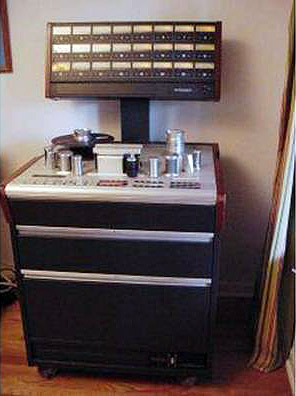
Studer A827 24 Track Analogue Tape Machine
The picture is of the 24 track version. The 16 track has the additional track width, and so is able to handle higher levels, and seems to go into distortion mode in a more gentle way than the 24 track.
These machines operate at speeds of 30 inches per second and 15 inches per second. Paradoxically, the performance of the machine is often better at the lower speed. This is to do with the ‘gap’ in the record head; at the higher speed, the tape ‘sees’ a smaller gap and this adversely affects the low frequency response. Many engineers much prefer to operate at 15 IPS particularly when recording pop music.
Alignment
Cost
Maintenance
Over the last 5 or so years it’s been fashionable for professional studios recording album projects to run both digital and analogue media simultaneously. For example, John Cornfield at his ‘Sawmills’ studio in Fowey (Cornwall) Installed a digital ‘multitrack’ system back in 1999, but continued to record on 2-inch analogue tape.
I was at his studio in 2001 at which time he was proudly showing me his shed full of removable hard drives, and how he was splitting the audio feeds so that he could choose between digital and analogue as his recording medium. But over a period of a year or so, he realised that he was never using the analogue tape to mix from…. The reality was that the digital medium was actually better in all respects; the operational advantages very soon meant that the 2-inch machine had become a curiosity, sitting in the corner as a conversation point; a subject of argument as to the relative merits of digital and analogue…
But given that the recording quality of digital hard disk is as good or better than analogue tape, the additional practical advantages of digital recording make it a ‘no brainer’ as the Americans say.
In digital, we have a system that is infinitely flexible; a system with as many ‘tracks’ as anyone could want; the ability to repeat, copy, overdub and edit non-destructively, and even to reproduce complete raw masters with no degradation. It is no wonder that the analogue tape has been consigned to the ‘specialist ‘ application.
Some engineers build their business trying to use what is now the rarity of the sound enhancement qualities of analogue tape. I know that it is fashionable to copy a mixed digital master onto a 2-track analogue tape machine such as the old 3M ‘Iso-loop’ machine or the Ampex ‘ATR’, so that they can access the magnetic tape compression that these machines give when they are modulated up to the limit. Perhaps they are right, perhaps it is more than a marketing ’emperor’s new clothes’ effect and it has a psychoacoustic effect in the ear of the record buyer (if there are any left). But I am not so sure.